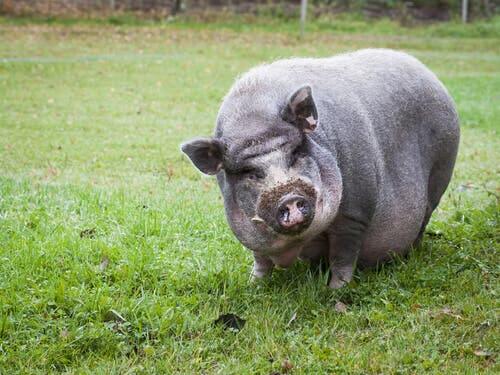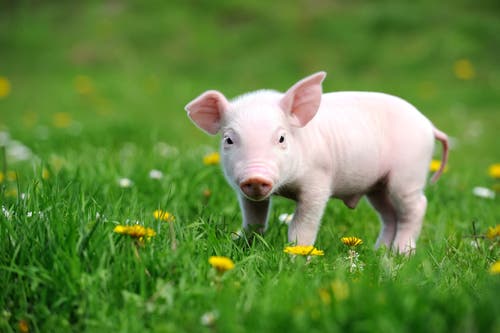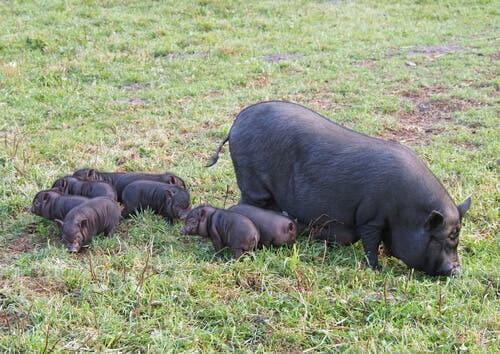Rearing Pigs in a Healthy Way


Written and verified by the lawyer Francisco María García
Rearing pigs requires specific knowledge to keep them healthy and look after their well-being. Here, we’ll go over some basic tips to help you raise your pigs.
The term ‘pig’ is a generic term that refers to various breeds of the mammalian species Sus scrofa domesticus. They typically have round, robust bodies, with a short tail, short hoofed legs, and four toes.
Despite their body weight, they’re quite agile and sensitive animals, and they’re also well known for their intelligence and learning capacity. When properly trained, they can memorize and obey different commands and can even perform much better than most other mammals.
Their naturally active and friendly character has led them to become popular pets too. If they’re properly trained, they can live perfectly fine with other animals and can interact affectionately with their owners.
Rearing pigs healthily with a well-balanced diet
Pigs are originally from tropical or temperate climates and tend to eat a mainly herbivorous and varied diet in their natural habitat. About 70% of their diet is based on a mix of fruits, vegetables, and legumes, as well as fresh grains and cereals.
Feeding a pig as a farmer
Most pigs are reared for their meat. Pork is a very popular meat in many dishes and pork proteins are recommended by nutritionists. In fact, the demand for pork is increasing, which means that intensive pig farming is becoming an attractive business opportunity.

Breeding for human consumption usually involves specific techniques to fatten the pigs and maximize profit. To do this, farmers use commercial feed with a very high concentration of carbohydrates, about 20% protein, and very little fiber.
Home farmers, on the other hand, tend to fatten their pigs through the use of portions of ground meat and organic leftovers.
Feeding a pet pig
These days, pigs have become popular pets, especially the Vietnamese pig. In this case, the idea isn’t to fatten up the pig, but to provide them with a well-balanced diet.
As a result, it’s best to steer clear of commercial feed as these products can lead them to easily become obese and suffer from a number of associated diseases.
When adopting a pig as a pet, it’s really important to respect their nutritional needs. You should opt for a natural diet and pay special attention to keeping their food fresh and in good condition.

That being said, it’s worth pointing out that many owners do still resort to artificial supplements and vitamins to keep their pigs healthy.
Staying hydrated
Just like all mammals, pigs need to keep hydrated, particularly in summer. In fact, whilst a pet pig can normally drink 4 pints of water a day, an adult pig that has been fattened for meat can drink almost double that.
But regardless of the reason you’re rearing pigs, it’s important to make sure that they have plenty of fresh, clean water available. Make sure you change it every day.
Environment and hygiene
Contrary to what you might have heard, pigs are actually very clean animals and don’t have a bad smell. What causes this is the poor care of their habitat. It’s really quite unfair to blame this on the pigs!
So, if you’re rearing pigs in a healthy way, you need to prioritize the cleaning of their habitat and their hygiene. We recommend that you give them a bath every two months to keep their skin and hair in good condition.
If you have a farm, it might be better to make sure they have access to a large reserve of water, such as a lake or pool. It’s also important to make sure they have an area somewhere where they can keep up their natural habit of digging and rolling in the mud.
Ideally, when rearing pigs, they should have an open area to roam around in with grass and soil. And since they’re native to warm, temperate climates, ideally they should be kept in temperatures of between 66°F and 75°F.
Physical exercise and domestication
In their natural habitat, pigs often walk and run freely throughout the day. They also reproduce frequently, since the females go into heat at various times of the year. This allows them to use up a lot of daily energy and naturally control their weight.

As a result, if you’re planning on rearing pigs, you’ll need plenty of space so that they can get some physical exercise. Walks outside and using incentives to get them to move around are also a good idea.
When it comes to domesticating pigs, it’s best to start training them at the age of two months old. At this age, piglets start to learn how to live with others and shape their behavior.
Health and medicine
Pigs are hardy creatures and rarely get sick. With a good diet and regular activities, your pig will stay strong and healthy. However, vaccinations and regular visits to a vet will also be important for keeping your pig as healthy as possible.
This text is provided for informational purposes only and does not replace consultation with a professional. If in doubt, consult your specialist.